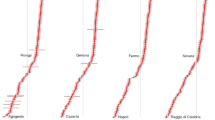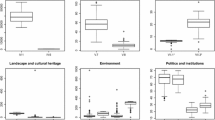Abstract
The Italian National Institute of Statistics (ISTAT) declined a multidimensional approach to measure equitable and sustainable well-being (Benessere Equo Sostenibile, BES) at a detailed territorial level, that is, at the provincial level (NUTS3) entailing a wide spectrum of indicators grouped into domains related to Health, Education, Work and life balance, Economic well-being, Social relationships, Politics and institutions, Security, Landscape and cultural heritage, Environment, Innovation research and creativity, and Quality of services. These indicators can help in describing the territories because they can spot situations of concern, such as in the South of Italy. The gap between North and South Italy has increased over time, a picture we can describe using each of the indicators, but also by jointly considering them by using a factor analysis and clustering and constructing a composite indicator. Contrary to some researchers who have suggested the employment of time series indicators for the period 2004–2016 looking for a latent factor, that takes into account the joint temporal trend of the indicators, in this paper, the situation among three different moments over time is compared: before the 2008 crisis and a few years after it. To do this, we have chosen a certain number of indicators on the basis of their features.










Similar content being viewed by others
Notes
The data are downloaded from https://www.istat.it/it/archivio/230627. In a previous presentation in abstracts SIEDS 2019, we used an ISTAT database published in 2018. In June 2019, a new database was issued by ISTAT, and the indicators are not always the same. The changes refer to variable definitions, introduction of new indicators, elimination of some previous ones, and time availability. See https://www.istat.it/it/benessere-e-sostenibilita/la-misurazione-del-benessere-(bes)/il-bes-dei-territori.
References
Abdi, H., Williams, L. J., & Valentin, D. (2013). Multiple factor analysis: Principal component analysis for multitable and multiblock data sets. WIREs Computer Statistics, 2013(5), 149–179. https://doi.org/10.1002/wics.1246.
Aggarwal, C. C. (2005). On change diagnosis in evolving data streams. IEEE Transactions on Knowledge and Data Engineering, 17, 587–600.
Bolasco, S. (1999). Analisi Multidimensionale dei Dati. Metodi, strategie e criteri d’interpretazione. Roma: Carrocci editore.
Ciommi, M., Gigliarano, C., Taralli, S., & Chelli, F. M. (2017). The Equitable end Sustainable Well-Being at local level: a first attempt of time series aggregation. Rivista Italiana di Economia Demografia e Statistica, 71(4), 51–60.
Chelli, F. M., Ciommi, M., Emili, A., Gigliarano, C., & Taralli, S. (2016). Assessing the equitable and sustainable well-being of the Italian provinces. International Journal of Uncertainty, Fuzziness and Knowledge-Based Systems, 24(Suppl. 1), 39–62.
Escofier, B., & Pages, J. (1998). Analyses Factorielles Simples et Multiples: Objectifs, Methodes et Interpretation (3rd ed.). Paris: Dunod.
ISTAT. (2013). BES-2013, Il Benessere Equo e Sostenibile in Italia. Retrieved October, 2019, from https://www.istat.it/it/files//2013/03/bes_2013.pdf
ISTAT. (2018). BES-2018, Il Benessere Equo e Sostenibile in Italia. Retrieved October, 2019, from https://www.istat.it/en/archivio/225140.
ISTAT. (2019). Misure del benessere dei territori. Anno 2018. Nota metodologica. Retrieved October, 2019, from https://www.istat.it/it/files//2019/05/Nota-metodologica.pdf
Lê, S., Josse, J., & Husson, F. (2008). FactoMineR: An R package for multivariate analysis. Journal of Statistical Software., 25, 1–18.
Maggino, F. (2017). Developing indicators and managing the complexity. In F. Maggino (Ed.), Complexity in society: From indicators construction to their synthesis (Vol. 70, pp. 87–114). Social indicators research series. Cham: Springer.
Mazziotta, M., & Pareto, A. (2017). Synthesis of indicators: The composite indicators approach. In F. Maggino (Ed.), Complexity in society: From indicators construction to their synthesis (Vol. 70, pp. 159–191). Social indicators research series Cham: Springer.
Mazziotta, M., & Pareto, A. (2019). Use and misuse of PCA for measuring well-being. Social Indicators Research, 142(2), 451–476. https://doi.org/10.1007/s11205-018-1933-0.
OECD. (2019). Measuring well-being and progress: Well-being research. Retrieved October, 2019, from https://www.oecd.org/statistics/measuring-well-being-and-progress.htm
Oliveira, M., & Gama, J. (2012). A framework to monitor clusters’ evolution applied to economy and finance problems. Intelligent Data Analysis, 16, 93–111.
Pages, J., & Husson, F. (2005). Multiple factor analysis with confidence ellipses: a methodology to study the relationships between sensory and instrumental data. Journal of Chemometrics., 19, 138–144.
Pages, J. (2014). Multiple Factor Analysis by Example Using R. London: Chapman and Hall/CRC.
Spiliopoulou, M., Ntoutsi, I., & Theodoridis, Y. (2009). Tracing cluster transitions for different cluster types. Control and Cybernetics, 38, 239–259.
Taralli, S. (2013). Indicatori di Benessere Equo e Sostenibile delle Province: informazioni statistiche a supporto del policy-cycle e della valutazione a livello locale. RIV Rivista Italiana di Valutazione., 55(2013), 171–187.
Author information
Authors and Affiliations
Corresponding author
Additional information
Publisher's Note
Springer Nature remains neutral with regard to jurisdictional claims in published maps and institutional affiliations.
Rights and permissions
About this article
Cite this article
Monte, A., Schoier, G. A Multivariate Statistical Analysis of Equitable and Sustainable Well-Being Over Time. Soc Indic Res 161, 735–750 (2022). https://doi.org/10.1007/s11205-020-02392-x
Accepted:
Published:
Issue Date:
DOI: https://doi.org/10.1007/s11205-020-02392-x




